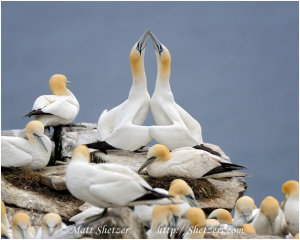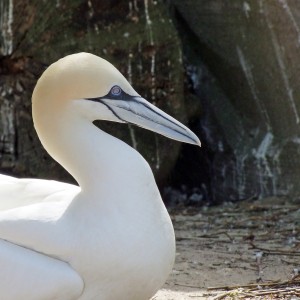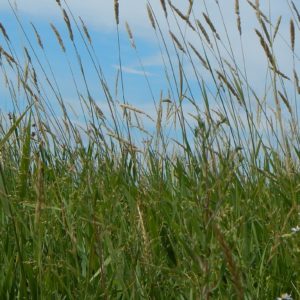The Northern Gannet – majestic in flight and raucous on land

Valerie Assinewe, Contributing Writer
Over the ocean, the Northern Gannet wheels and soars majestically in the sea wind but on land, it waddles and stumbles in its raucous, smelly and crowded colony. This is what I remember most of our visit to Bonaventure Island.
On our eastern Canada camping trip in 1987, my family and I were able to visit the Bonaventure Island colony of the Northern Gannet. From the boat tour and the walk to the colony on the cliff, we learned some interesting facts about this bird (additional facts from a recent internet review are in parenthesis):
- They are not seagulls as I thought but rather seabirds (more closely related to Bobbies and other birds of the order Suliformes).
- The gannets up close are large (Length: 85-97 cm). They have long narrow wings (Wingspan: 170-192 cm) and a long neck. The adult plumage is white with black tips to the wings and a yellowish head. There is a ring of bluish skin around the eyes.
- The colony is a breeding site so it is only active between March and September.
- The nests are on any ledge or flat ground, often perilously close to the cliff edge and always just out of pecking range of the neighbours. Much pecking, flapping of wings and cries ensue when nesting territories are crossed even by adults landing just too close or chicks roaming from their nests.

Photo of Northern Gannets by Matt Shetzer
- The mound nest consists of seaweed, feathers and plant material.
- Both parents feed the young by regurgitation.
- The birds standing face to face, wings out, knocking bills together and bowing are mated pairs greeting each other. The birds looked the same to me but apparently,one could identify the female from the male: the females have green lines on the toes whereas the males have more yellowish lines. Wary of the bird’s sharp beak and respectful of the locale signage of disturbing the nesting area, I trusted the word of the guide for this ID tidbit.
Some other important facts about the Northern Gannet:
- Generally, only one pale blue, chalky egg is laid in late April or May.
- The incubation takes between 43 and 45 days, and is carried out by both parents.
- Juveniles are greyish-brown in colour with white freckling. The white colouration increases to maturity.
- The age at first flight is between 84-97 days.
- From their colony, gannets can travel over 200 km in search of mackerel, herring, capelin and sand lance.
- Between September and March, i.e. the non-breeding months, the gannets range southerly along the Atlantic coast and into the Gulf of Mexico. Immatures (younger than 5-6 years) tend to winter further south than the adults and may remain south of the breeding grounds in summer.
- Northern gannets are a sentinel species (or bioindicator) of the state of the Gulf of St. Lawrence because they have an expansive feeding ground in this region and their diet is rich in fish that can provide information on the abundance of its prey and the degree of contamination of the ecosystem.

Image of a Northern Gannet
Canada is home to six Northern Gannet colonies. Three are along the east coast of Newfoundland: Funk Island, Baccalieu Island and Cape St. Mary’s. Three others are in the Quebec portion of the Gulf of St. Lawrence: the colonies of the eastern tip of Anticosti Island, Bird Rocks in the Magdalen Islands and Bonaventure Island, which together make up 75% of the North American population of the Northern Gannet. All six colonies are designated as Important Bird Areas (IBA).
Should your travels take you anywhere near these colonies, do visit because these birds are truly magnificent to watch and the colonies are a study in group behaviour and an indicator of the health of the marine ecosystem.




